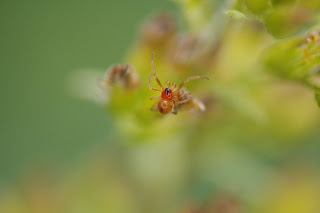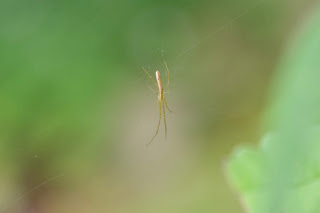Also amazing to me is that in this 7th year of looking for bugs in my backyard I still find things I have never seen before. Like today's Backyard Bug of the Day:
When I first spotted this beetle I thought it was a bee. You can probably see why–I saw it from the front, and what I saw was yellow and black, fuzziness, kind of big for a bumblebee, but not the biggest, bee-like shape, bee-like posture. When I saw the orangeness, I thought that was the pollen packets they carry around on their legs, until I got closer and changed my vantage point and saw that it was actually the bug itself that had orange markings. And then I noticed that it's not a bee at all, it's a beetle.
Look at those cool antennae!
This is a sexton beetle, also known as a burying beetle, which is a kind of carrion beetle. Carrion beetles are so-called because they eat carrion. Dead animals. Burying beetles bury dead animals–birds and small mammals–and lay their eggs on the buried carcasses. They and their young feed on the carrion. Gross, but obviously a vitally important part of the cycles of nature. This species is called Nicrophorus tomentosus.
A part of my would like to see these beetles burying something because that actually sounds impressive, and a part of me thinks that would be really gross. And thinking about it (ew), if this beetle is in my backyard, there must be something for it to be eating, and burying. But I don't see dead things things lying around in my backyard very often–usually if there's evidence of animal death its the feathers left behind when a bird of prey has eaten another bird. Obviously there must be animals that die out there, at the very least squirrels, and chipmunks, and other small rodents. It's curious that I don't see that. I am quite glad of that fact, believe me. Obviously those creatures in nature who are responsible for cleaning up the remains are doing a good job, whether its scavengers like vultures and coyotes, or carrion beetles. This has turned rather morbid...
Cool feet, too.
Now, about those other bugs that I didn't see yesterday:
Ladybeetle larva. It looks like it's nearly to its full pre-pupating size. It's on one of the milkweed plants. I am a bit surprised to find one so big without having seen any when they were smaller. I did see ladybeetles yesterday, but the larva counts as a different sighting.
Ailanthus webworm moth, a big fan of goldenrod.
Crane fly. I did see crane flies yesterday, and even took a picture of one. In fact, I saw lots of crane flies yesterday, and have been seeing lots of them for the last couple of weeks. They have not been willing to have their picture taken, though (and the picture I took yesterday wasn't good enough to post).
Assassin bug nymph. I saw the imago (adult) of this species yesterday, and today I found the nymph.
Some kind of fly, I think.
I saw crickets yesterday, but I don't think I saw this species. I didn't get pictures of this species, anyway.
Today these little crickets were all over the backyard.
There have been lots of different bees and wasps for the last few days. I didn't get this one yesterday. On goldenrod.
I did see a candy striped leaf hopper yesterday, but this one is different in that it is alive and not being eaten by a spider like the one yesterday.
Plant bug of some kind
Buffalo tree hopper. Notice that it is excreting a drop of honeydew.
Some kind of Hemiptera nymph.
Leaf footed bug
A leaf hopper I didn't see yesterday.
Banded hairstreak butterfly
Yesterday I saw a couple of stinkbugs; today I saw a stinkbug nymph.
Moth hiding among pine needles
And the rest of these I found yesterday and today, and for some of these practically every day. I didn't bother to photograph a lot of what I saw today because it was a lot of the same stuff I saw yesterday and every day, but I did get a few of them:
Fall webworm
Ditto
The eastern tailed blue is still hanging around. No, this picture is not upside down, the butterfly is.
I still don't know what this is.
Woolly bear (aka Isabella tiger moth caterpillar)
This is the adult version of the assassin bug nymph above. One thing about learning about bugs the way I have done, primarily by just going outside and looking at what's out there, is that I didn't know anything about nymphs, and how they are not like larvae, how they resemble the adult version of their species a bit more. So when I saw assassin bug nymphs like the one above, and assassin bug adults like this one, it was a while before I realized that those were two stages of the same species, not different kinds of bugs. It was strangely thrilling when I figured that out. I love learning things!
Not terribly cooperative, but I got an okay look at the underside of the pearl crescent's wings today.
The Japanese knotweed flowers were not as popular the last two days, but there were still a fair few insects feeding on them... and at least this one assassin bug hoping to feed on those insects.
.
.
.
.
.
.
.
.
.
.
.
There were several spider species that I saw today that I didn't see yesterday, too:
Some kind of crab spider
I don't know what this tiny spider is, but I always mentally name it the tomato spider because it looks like it is made of tiny tomatoes.
I saw jumping spiders yesterday, but not this species.
Spined micrathena
And the rest I saw yesterday, too:
These next two spiders were neighbors on the same mountain mint plant:
Nursery web spider
Flower crab spider
I went looking for the orb weaver I saw building a web yesterday, and had a hard time finding it. It was not in the middle of its web, it was hidden off to the side among the needles of the bush where its web is. It was in the process of wrapping prey in silk. Obviously I did not get a good picture of it, but it's always more interesting to see insects and spiders doing things rather than just sitting around.
Flower crab spider with prey















































No comments:
Post a Comment